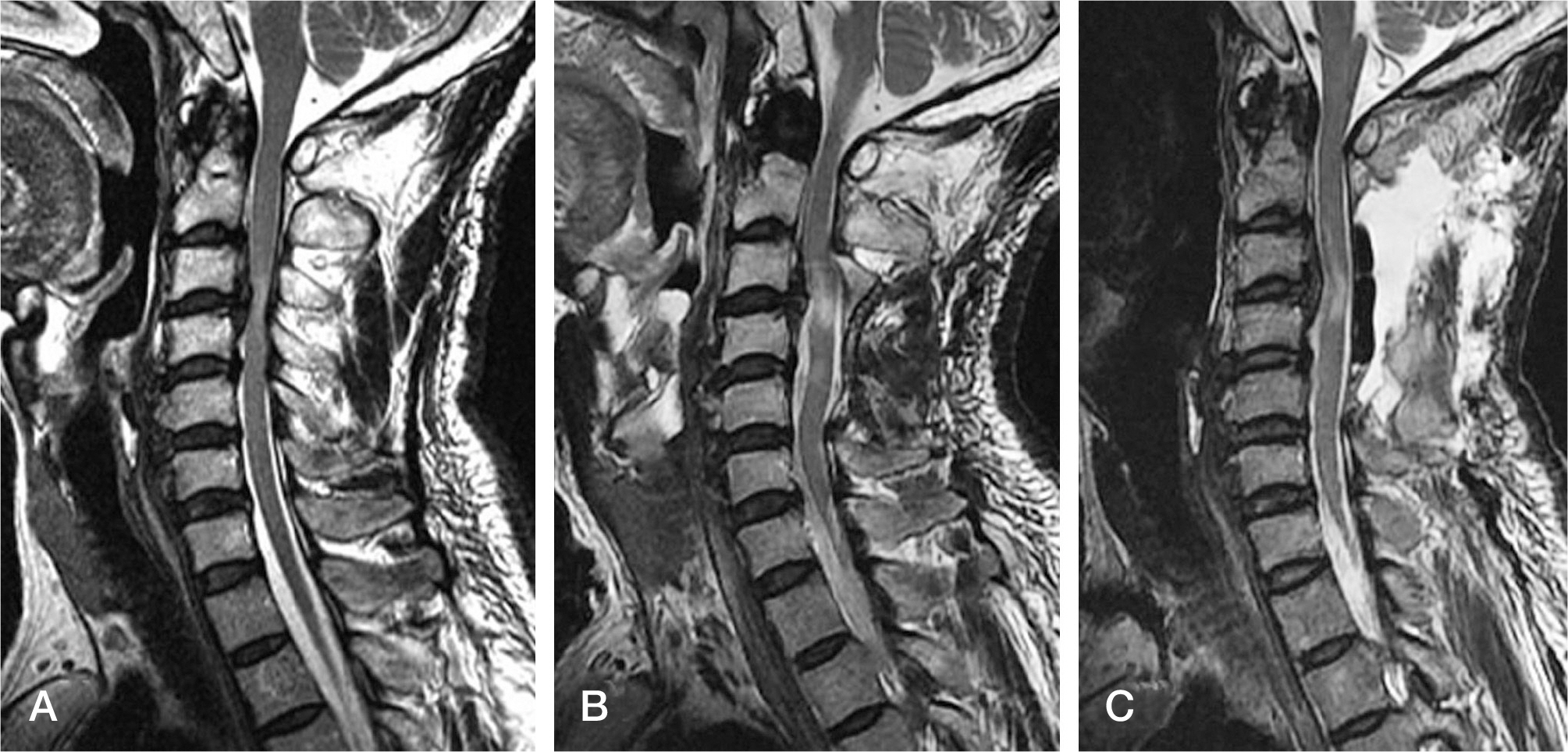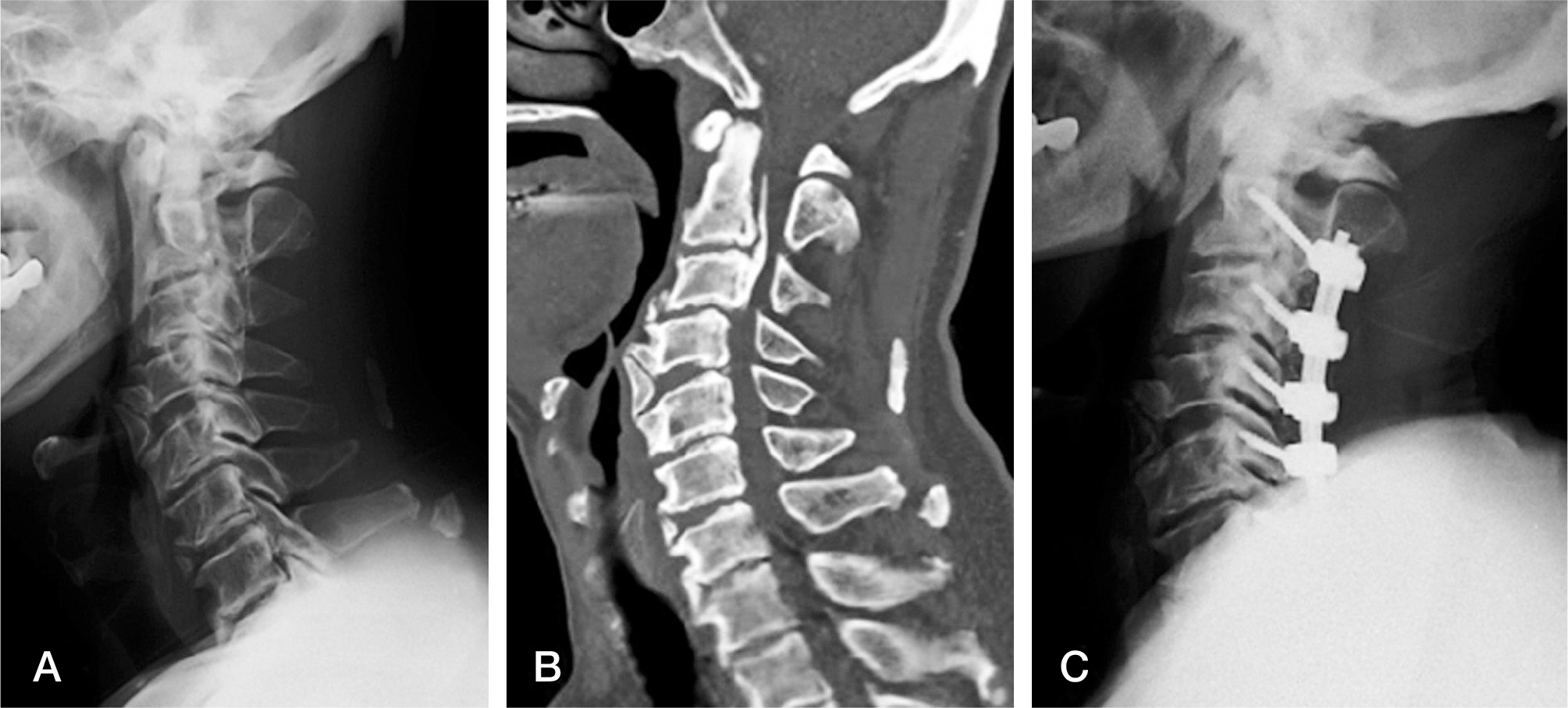J Korean Soc Spine Surg.
2014 Jun;21(2):97-102. 10.4184/jkss.2014.21.2.97.
Suspicious Reperfusion Injury of Spinal Cord After Multilevel Cervical Posterior Decompression without Remarkable Surgical Insult: Two Case Reports
- Affiliations
-
- 1Department of Orthopedic Surgery, College of Medicine, Dong-A University, Korea. gylee@dau.ac.kr
- KMID: 1800405
- DOI: http://doi.org/10.4184/jkss.2014.21.2.97
Abstract
- STUDY DESIGN: Two case reports.
OBJECTIVES
We present two cases of quadriplegia after posterior decompression with fusion caused by a suspicious reperfusion injury of spinal cord without remarkable surgical insult. SUMMARY OF LITERATURE REVIEW: Posterior decompression and posterolateral fusion have been reported as effective procedures in patients with multilevel myelopathy. However, postoperative spinal cord injury without remarkable intraoperative technical damage has been reported in a few articles. Reperfusion mechanism was suggested as one of the leading causes and reported in some animal models.
MATERIALS AND METHODS
There was one case of ossification of the posterior longitudinal ligament and one developmental multilevel stenosis that underwent laminectomy with lateral mass instrumentation. After surgery, the patients presented with quadriplegia; MRI demonstrated swelling of the spinal cord and intramedullary lesion in two cases.
RESULTS
After surgery, the patients presented with quadriplegia; MRI demonstrated swelling of the spinal cord and intramedullary lesion in two cases.
CONCLUSION
Although patients with such a medical condition are rare, it is difficult to predict postoperative swelling of the spinal cord before surgery. The surgeon should thus be aware of such rare disease conditions involving the spinal cord before the surgical procedure.
MeSH Terms
Figure
Reference
-
1. Hukuda S, Mochizuki T, Ogata M, Schichikwa K, Shimo-mura Y. Operations for cervical spondylotic myelopathy. A comparison of the results of anterior posterior procedures. J Bone Joint Surg. 1985; 67:609–15.2. Lee CW, Kang JH, Lee KY, Sung HW. Laminoplasty versus laminectomy and fusion for multilevel cervical spondylosis. J Korean Spine Surg. 2010; 17:147–53.
Article3. Chiba K, Toyama Y, Matsumoto M, Maruiwa H, Wata-nabe M, Hirabayashi K. Segmental motor paralysis after expansive open-door laminoplasty. Spine (Phila Pa 1976). 2002; 27:2108–15.
Article4. Shimizu T, Shimada H, Edakuni H. Postlaminoplasty palsy of upper extremities, with special reference to the spinal cord factors in Japanese. Bessatsu Seikeigeka. 1996; 29:188–93.5. Okada M, Minamide A, Endo T, et al. A prospective randomized study of clinical outcomes in patients with cervical compressive myelopathy treated with open-door or French-door laminoplasty. Spine (Phila Pa 1976). 2009; 34:1119–26.
Article6. Gebarski SS, Maynard FW, Gabrielsen TO, Knake JE, Latack JT, Hoff JT. Posttraumatic progressive myelopathy: Clinical and radiologic correlation employing MR imaging, delayed CT metrizamide myelopathy, and intraoperative sonography. Radiology. 1985; 157:379–85.7. Schwartz ED, Falcone SF, Quencer RM, Green BA. Post-traumatic syringomyelia: pathogenesis, imaging, and treatment. AJR Am J Roentgenol. 1999; 173:487–92.
Article8. Dumont RJ, Okonkwo DO, Verma S, et al. Acute spinal cord injury, part I: pathophysiologic mechanisms. Clin Neuropharmacol. 2001; 24:254–64.
Article9. Kim-Lee MH, Stokes BT, Yates AJ. Reperfusion paradox: A novel mode of glial cell injury. Glia. 1992; 5:56–64.
Article10. Oyinbo CA. Secondary injury mechanisms in traumatic spinal cord injury: a nugget of this multiply cascade. Acta Neurobiol Exp (Wars). 2011; 71:281–99.
- Full Text Links
- Actions
-
Cited
- CITED
-
- Close
- Share
- Similar articles
-
- White Cord Syndrome: A Reperfusion Injury Following Spinal Decompression Surgery
- Acute Spinal Cord Injury after Cervical Nerve Root Block
- Degenerative Cervical Myelopathy: Pathophysiology and Current Treatment Strategies
- Spinal cord injury in the type II decompression sickness
- Analysis of Preoperative Factors Affecting Postoperative Spinal Canal Expansion after Posterior Decompression for the Treatment of Multilevel Cervical Myelopathy





